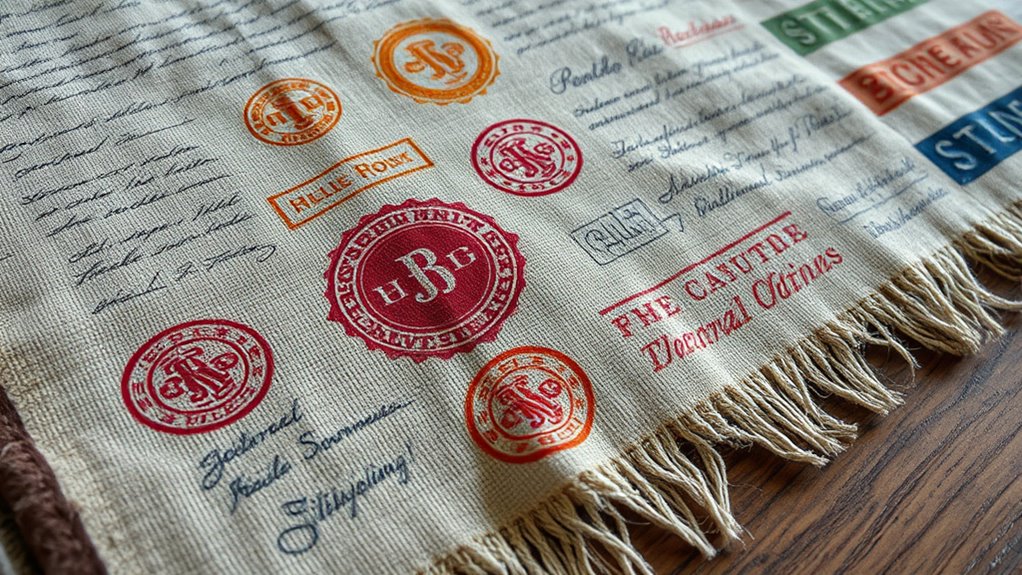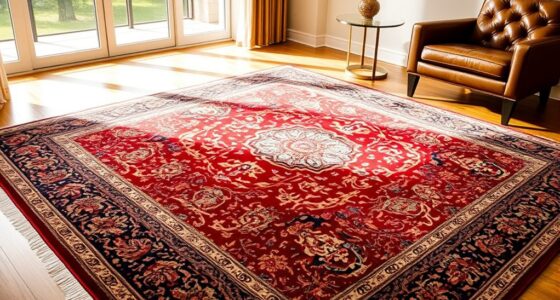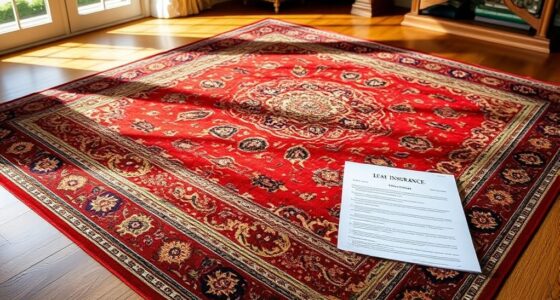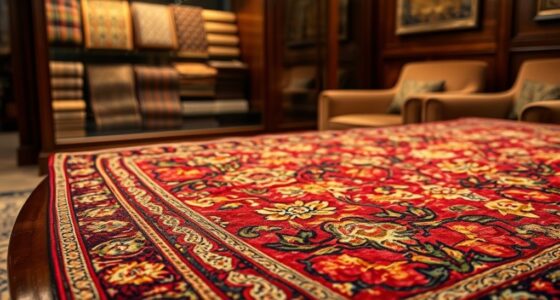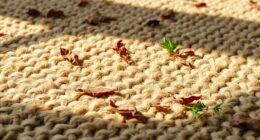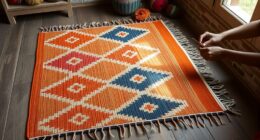To determine a rug’s provenance, examine its signatures, stamps, and labels carefully. Look for handwritten marks that reveal the craftsman’s unique style, official stamps that indicate origin and authenticity, and labels that provide manufacturer or export details. Consistent patterns, symbols, and placement help verify the piece’s history and legitimacy. By analyzing these clues, you’ll uncover valuable insights into its origins—and there’s more to discover as you continue exploring these identification methods.
Key Takeaways
- Examine signatures, stamps, and labels for consistent design features, placement, and symbols to verify authenticity and origin.
- Compare markings with known examples to trace provenance and identify forgeries or counterfeit items.
- Analyze dye patterns, weaving techniques, and craftsmanship signs linked to specific regions or workshops.
- Check label details such as manufacturer information, export stamps, and knot counts for quality and authenticity clues.
- Use unique serial numbers and codes to track production history and confirm the rug’s documented provenance.
Recognizing Handwritten Signatures and Their Significance
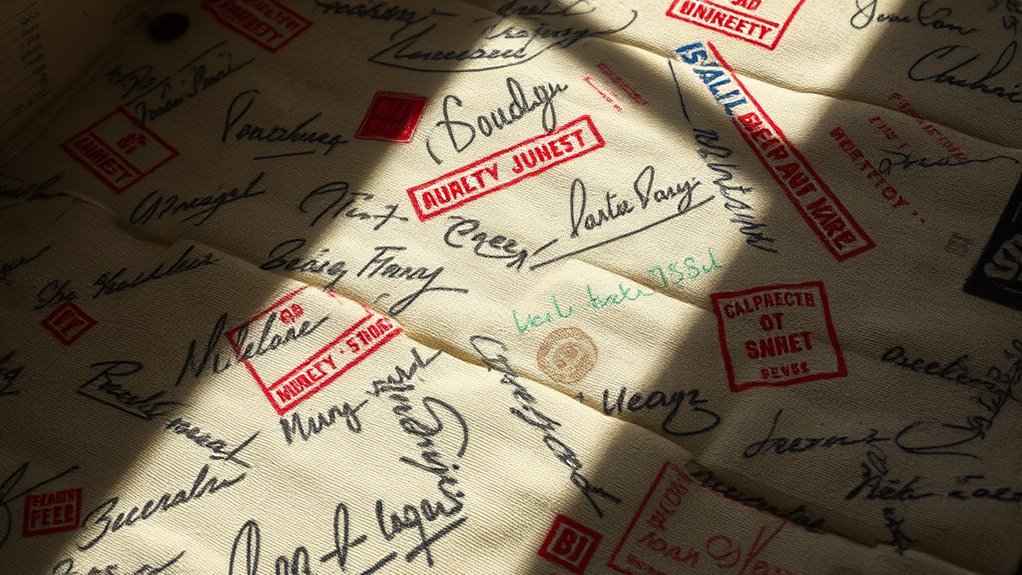
Handwritten signatures play an essential role in verifying the authenticity of documents, making their recognition an essential part of provenance analysis. Your goal is to identify unique handwritten signatures and understand their signature styles. Look closely at the way the signatures flow—distinguishing between sharp, angular strokes and smooth, rounded curves. Pay attention to letter formations, spacing, and pressure variations, as these details reveal individual traits. Signature styles can vary widely, from elegant cursive to quick, informal marks. Recognizing these subtle differences helps establish authenticity and trace provenance back to the original signer. Practice comparing known signatures with new ones, noting consistent features and irregularities. Mastering this skill enhances your ability to verify documents accurately and understand their historical context. Additionally, understanding somatic therapy techniques can help individuals develop greater awareness of their body’s responses, which may further assist in recognizing personal signature characteristics through physical cues. Developing an understanding of essential oil properties, such as their flow and application patterns, can also metaphorically aid in recognizing consistent personal traits in handwritten signatures. Furthermore, analyzing pressure variations in signatures can provide insights into the signer’s emotional state or intent at the time of signing, which aligns with the importance of personal finance management in understanding individual behaviors. Incorporating visual analysis techniques from related fields can improve accuracy in identifying signature authenticity.
Deciphering Official Stamps and Their Origins
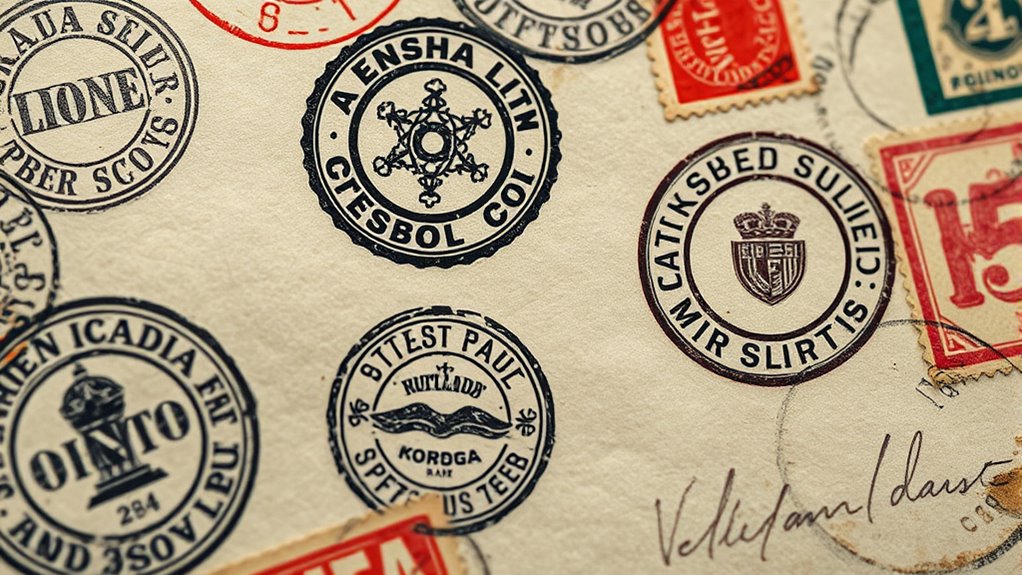
When you examine official stamps, look for key indicators of authenticity, such as specific markings or design features. Tracing the origins of a stamp helps confirm its legitimacy and connects it to a particular time or authority. Understanding these elements guarantees you accurately interpret the stamp’s significance in provenance. Recognizing design features can provide insights into the period and authenticity of the stamp, especially when compared to known examples. Additionally, analyzing city and country markings can further validate the stamp’s origin and historical context. Incorporating knowledge of collectible trends can also help assess the stamp’s value and significance within its provenance. Familiarity with banking codes like SWIFT/BIC can assist in tracing the origin of related documents or correspondence, further supporting provenance verification. Being aware of production techniques can reveal the manufacturing methods used, offering more clues about the stamp’s origin and era.
Recognizing Authenticity Indicators
Official stamps serve as vital indicators of authenticity, providing visual proof that a document or item is genuine. When examining textiles, look for consistent weaving techniques that reflect specific craftsmanship traditions, which can confirm origin and authenticity. Recognizing authentic weaving patterns can help verify the item’s provenance and craftsmanship quality. Dye patterns also play a pivotal role; authentic pieces often feature unique, historically linked dye styles that match known regional methods. Recognizing these indicators helps you verify the item’s provenance beyond just the official stamp. Authentic stamps may include symbols or inscriptions tied to a particular workshop or certification authority. By carefully analyzing weaving techniques, dye patterns, and the design of official stamps, you strengthen your ability to distinguish genuine pieces from forgeries or reproductions, ensuring your collection maintains its integrity and value. Authenticity indicators provide additional context for understanding the item’s true origin.
Additionally, understanding the original context of the stamp can reveal important details about the item’s history and authenticity, especially when considering the regional craftsmanship associated with specific regions or workshops.
Tracing Stamp Origins
Deciphering the origins of official stamps requires close examination of their design elements, symbols, and inscriptions. Look closely at the artistic brushstrokes, which can reveal stylistic influences and craftsmanship details. Analyzing the color palette helps determine the period and origin, as certain hues and combinations were popular in specific regions or eras. Pay attention to the arrangement of symbols and text, as they often indicate official authority or geographic location. Comparing these features with known examples can help you trace the stamp’s provenance. This detailed analysis allows you to differentiate authentic stamps from forgeries and understand their historical context. Recognizing regional design trends can also provide valuable clues about the geographic origin and historical period of the stamp. Understanding the symbolism embedded within the design can reveal additional information about the issuing authority and cultural influences. Incorporating knowledge of collecting techniques can further refine your ability to assess the authenticity and value of the stamp. By combining visual inspection with knowledge of regional design trends, you can confidently trace a stamp’s origin and verify its significance in the provenance chain. Additionally, understanding the Law of Attraction principles can enhance your ability to focus on positive outcomes when engaging in detailed research or collecting authentic items.
Understanding Manufacturer and Export Labels
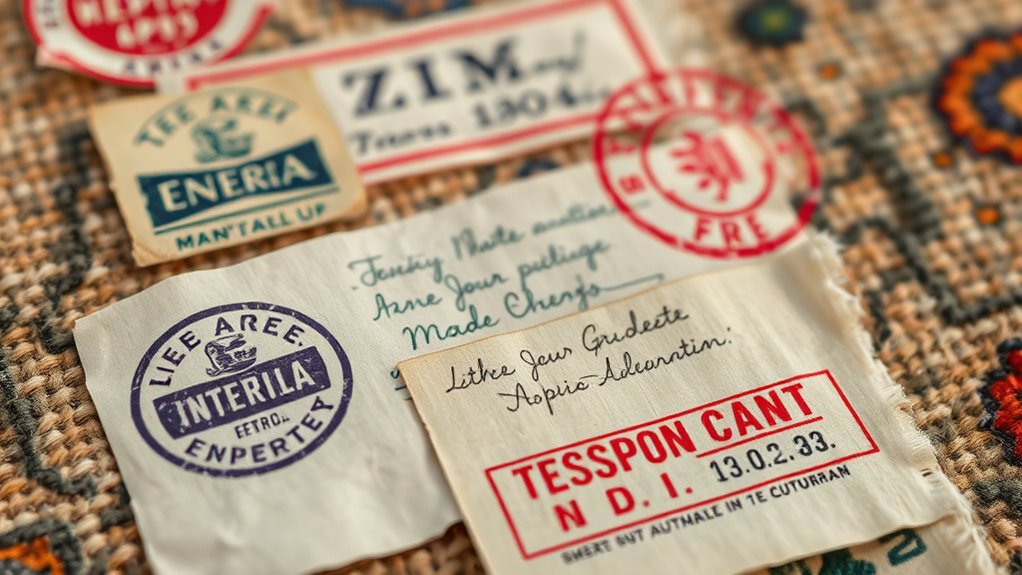
You’ll want to pay attention to where manufacturer and export labels are placed, as their position can reveal important details. Look for markings that indicate the item’s country of origin or manufacturing site, which help verify authenticity. Additionally, check for export documentation details that confirm the item was legally shipped and received.
Label Placement Significance
The placement of manufacturer and export labels on a product can reveal essential information about its origin and authenticity. Labels found inside or on the back of a rug often indicate the maker’s identity or export details. Sometimes, dye analysis of labels can suggest regional dyeing techniques, while knot count may be referenced for quality assessment. Pay attention to labels near the selvage, which often showcase craftsmanship details or specific dye sources. Proper placement can also help verify if the rug was produced for export or local use. Below is a helpful guide:
| Label Location | Significance |
|---|---|
| Inside rug | Indicates original manufacturer’s info |
| Back of rug | Reveals export or certification stamps |
| Near selvage | Shows craftsmanship and dye source details |
| Edges or corners | Often used for quality or regional identifiers |
Markings Indicating Origin
Marks indicating a rug’s origin, such as manufacturer and export labels, provide essential clues about where and how the piece was made. These labels often reveal details about textile dyeing methods and rug weaving techniques, helping you understand the craftsmanship involved. Here are three key aspects to look for:
- Country of Origin: Labels often specify the country, indicating regional weaving styles and traditional dyeing practices.
- Manufacturer’s Markings: These can include symbols or names that reflect specific weaving techniques unique to a workshop or region.
- Export Labels: They may detail the dye sources or processing methods, informing you about the textile dyeing processes used in production.
Together, these markings help decode the rug’s provenance and the techniques behind its creation.
Export Documentation Details
Have you ever wondered what export documentation on a rug reveals about its origins? Labels and stamps often include details like fiber composition and dye sources, helping you verify authenticity. They also specify manufacturing and export locations, confirming provenance. By examining these labels, you can identify the country of origin and understand the craftsmanship involved. The table below highlights key information found on export documentation:
| Feature | What it tells you |
|---|---|
| Fiber Composition | Materials used, like wool, silk, or synthetic fibers |
| Dye Sources | Natural or synthetic dyes, indicating craftsmanship |
| Manufacturer Label | Brand or workshop details |
| Export Stamp | Official export or customs approval |
These details ensure transparency, helping you assess rug authenticity and provenance more confidently.
The Role of Numerical Codes and Serial Numbers

Numerical codes and serial numbers serve as essential tools for tracking and verifying the origin of items. They act as unique identifiers, helping you confirm authenticity and trace provenance. Here’s how they work:
Numerical codes and serial numbers verify authenticity and trace item provenance effectively.
- Identification: Each rug or item gets a specific serial number, making it easy to distinguish it from others.
- Record Keeping: Numerical codes link to detailed records about the production date, location, and craftsman.
- Verification: When appraising or authenticating, these codes allow you to cross-check with official databases or provenance documents.
Spotting Authenticity Markers and Counterfeit Indicators

Ever wondered how to tell if a rug is genuine or a clever counterfeit? Spotting authenticity markers involves examining woven rug patterns closely. Authentic rugs often display consistent, intricate designs, while counterfeits may show uneven or blurry motifs. Pay attention to how the patterns align and the precision of the weaving. Dye lot variations can also reveal fakery; genuine rugs usually have subtle, natural color shifts, whereas counterfeit pieces often show abrupt or unnatural color differences. Look for signs of uniform dye application or inconsistent hues, which may indicate mass-produced or fake rugs. Genuine rugs reflect skilled craftsmanship with careful attention to detail, while counterfeits tend to lack this finesse. Becoming familiar with these markers helps you distinguish authentic pieces from imitations effectively.
Combining Clues to Trace a Rug’s Full History

To trace a rug’s full history, you need to piece together multiple clues from its physical attributes, provenance records, and stylistic details. Start by examining antique rug motifs, which reveal regional styles and time periods. Next, consider dye analysis to identify natural or synthetic dyes, helping date the rug and confirm authenticity. Additionally, look for signs of repairs or wear that tell a story of use and ownership. Combining these clues creates a clearer picture of the rug’s journey. For example:
Piecing together motifs, dyes, and signs of wear reveals a rug’s unique history and origins.
- Recognize regional motifs to place the rug geographically.
- Use dye analysis to determine age and origin.
- Observe wear patterns and repairs for ownership history.
Together, these elements help you build a extensive narrative of the rug’s provenance.
Frequently Asked Questions
How Can I Verify the Authenticity of a Signature on a Rug?
To verify a rug’s signature, you should start by examining its details closely and compare them with known authentic examples. Conduct fiber analysis and dye testing to check the materials and colors, ensuring they match the rug’s supposed origin and age. Consulting a professional appraiser or using reputable authentication services can also help confirm the signature’s authenticity, giving you confidence in your rug’s provenance.
Do All Stamps Indicate the Same Country of Origin?
Like a tapestry of diverse threads, stamp variations reveal a rich mosaic of origins. Not all stamps point to the same country of origin; each carries unique markings, styles, and symbols that serve as clues to country identification. You’ll find that stamps are as varied as fingerprints, reflecting different regional traditions. Carefully examining these distinctions helps you trace a rug’s provenance, ensuring you understand its genuine roots amid the colorful fabric of global craftsmanship.
Are Labels Always Reliable Indicators of a Rug’S Age?
You might wonder if labels are always reliable indicators of a rug’s age, but label accuracy can vary. While labels can provide useful clues, they aren’t foolproof for signature verification or dating. Some labels might be added later or forged, so don’t rely solely on them. Cross-check with other provenance details and signs of wear to better determine a rug’s true age.
What Do Serial Numbers Reveal About a Rug’S Manufacturing Date?
Imagine peeling back a rug’s threads like pages in a storybook—serial numbers act as its chapters. They reveal the manufacturing date, linking you to specific techniques and regional variations. As you decode these numbers, you uncover clues about when and where the rug was made, offering insight into its history and craftsmanship. Serial numbers serve as a timeline, connecting you directly to the origins behind each intricate weave.
How Can I Distinguish Genuine Markers From Counterfeit Ones?
To distinguish genuine markers from counterfeit ones, you should analyze the dye and compare fibers. Authentic markers often use natural dyes and consistent fiber types, while counterfeits may show unnatural dyes or inconsistent fibers. Conduct dye analysis to verify color authenticity and fiber comparison to guarantee material consistency. These steps help confirm the provenance, making it easier to spot genuine signatures versus fake ones.
Conclusion
By mastering how to read signatures, stamps, and labels, you reveal the incredible history behind each rug—like holding a secret map to its soul. Every mark you decipher brings you closer to understanding its true origin, authenticity, and journey. With these skills, you become a detective of textile mysteries, uncovering stories more fascinating than you ever imagined. Embrace the challenge, and soon you’ll be unraveling rug histories with the precision of a seasoned expert—nothing less than extraordinary!
